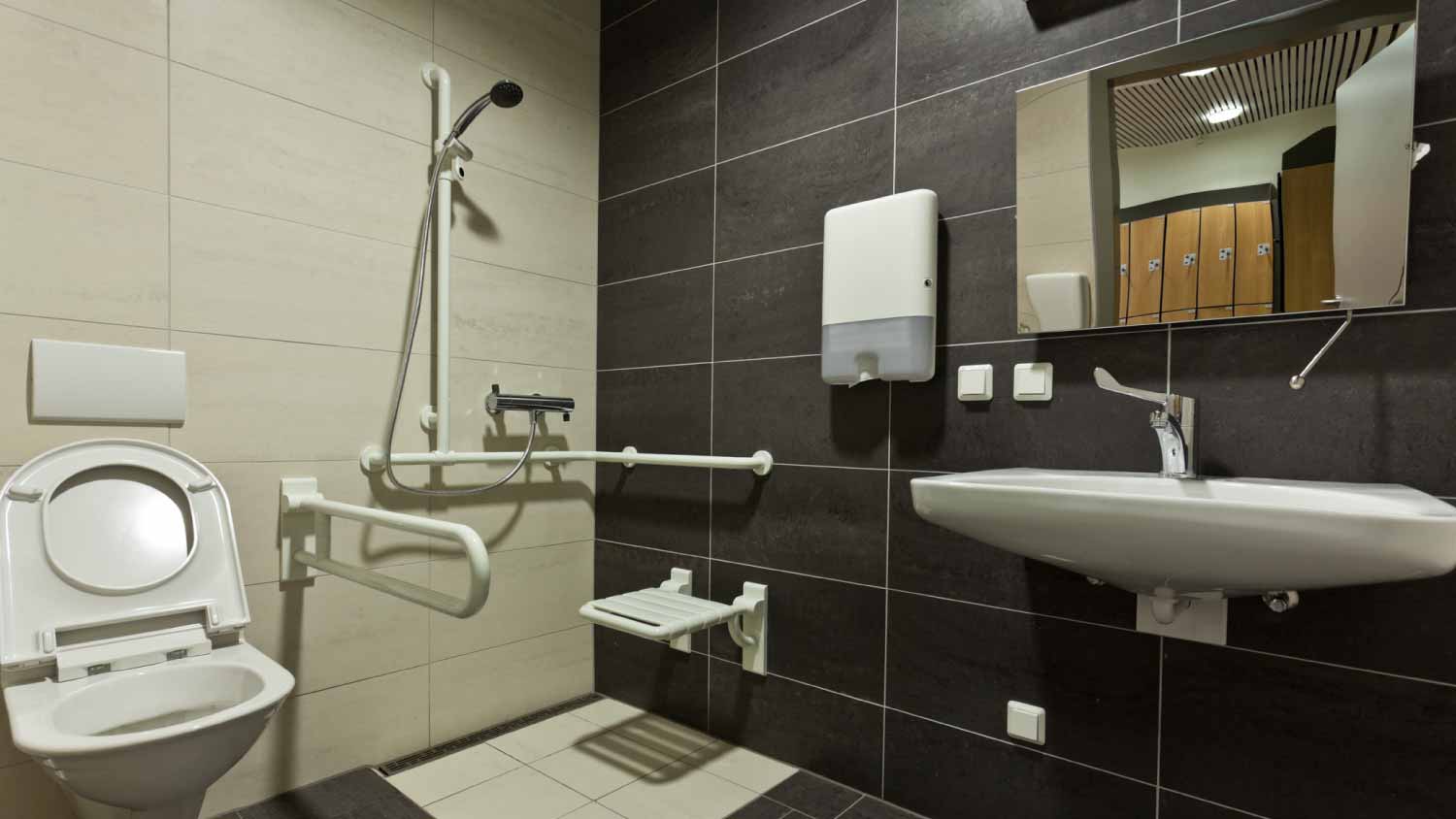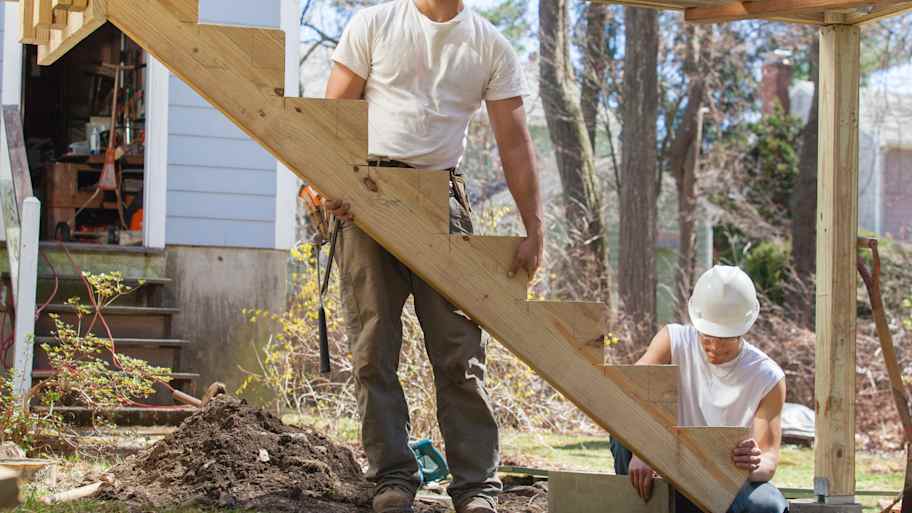
Looking to turn your yard into a hockey or ice skating paradise this winter? Use this backyard ice rink cost guide to see what the installation will total.
The average U.S. homeowner spends $3,800 on a roll-in shower, but the cost ranges from $2,900 to $4,600, depending on the project scope.


Roll-in showers cost an average of $3,800 but can range from $2,900 to $4,600, depending on the size and features.
Pros charge labor fees between $300 and $2,000, while conversion kits cost $600 to $3,200.
Factor in costs for demolition ($50 to $100), wall removal ($300 to $1,000), cleanup ($100 to $800), and permits (about $250).
Plumbing additions or updates increase labor costs by $45 to $200 per hour, and features like benches and handrails add to the budget.
Accessible remodels can yield a return on investment (ROI) of 70%, making them one of the most valuable bathroom upgrades.
Installing a roll-in shower is one universal design feature that accommodates anyone who needs assistance in the shower—not to mention, that bathroom remodels can even increase the value of your home. Roll-in showers cost anywhere from $2,900 to $6,600 for standard-sized projects. Most homeowners pay $3,800 on average.
Let’s examine the financial aspects of installing a roll-in shower so you can feel prepared for your project.

The average cost of a roll-in shower for materials alone is $2,600, but prices can range from $600 to $4,600. This means that your standard 30-by-60-inch roll-in shower could cost anywhere from roughly $50 to $375 per square foot. Standard roll-in showers must be at least 30 inches wide by 60 inches deep to ensure occupants have ample room. Here’s a breakdown of the cost of roll-in showers by size, not including labor:
| Roll-In Shower Size (inches) | Total Square Feet | Average Cost |
|---|---|---|
| 60 X 30 | 12.5 | $2,600 |
| 60 X 32 | 13.5 | $2,900 |
| 60 X 36 | 15 | $3,200 |
| 62 X 36 | 16 | $3,400 |
| 63 X 39 | 17 | $3,600 |
The average plumber charges between $45 and $200 an hour, depending on their level of expertise. Let’s break down each plumber level and associated costs so you can budget for the experience level your home requires to complete the project.
| Plumber Level | Average Hourly Rate |
|---|---|
| Apprentice | $45–$90 |
| Journeyperson | $60–$110 |
| Master | $80–$200 |
Plumbers are your go-to professionals for bathroom renovations and remodeling projects where plumbing is involved. Your plumber may complete any of these common projects:
Pipe replacement: $1,200
Rough-in plumbing for a bathroom: $6,500
Shower installation: $8,200
Walk-in bathtub: $9,000
If you need rewiring in your bathroom to provide light to your new roll-in shower, then you might also need to hire an electrician to get the job done. An electrician charges between $40 and $120 an hour on average, with apprentices falling toward the lower end of the price range and master electricians falling toward the higher end. A few projects your electrician may offer for your roll-in shower installation include:
Installing an outlet: $300
Adding a light fixture: $600
Rewiring: $1,600
Most general contractors charge between $300 to $500 a day on average, plus $150 to $250 per day for every additional worker. Since the average time to complete a walk-in shower is one to four days, you could spend between $300 and $2,000 in total. Their hourly rate varies from $50 to $150, with additional laborers charging between $40 to $50 per hour. General contractors are beneficial because they cover a wide range of projects around the house.
Here are several common projects and the cost to complete them:
Bathroom addition: $22,000
Bathroom remodel: $12,100
Home remodel: $47,000
In addition to your typical project expenses for roll-in showers, you’ll want to factor in demolition and prep work, cleanup, and permit costs.
If you’re building a roll-in shower in place of an already existing shower space, then you’ll want to factor in demolition costs. On average, it costs $50 to $100 to remove an old shower. You’ll spend between $300 to $1,000 on non-load-bearing wall removal costs.
After demolishing your existing shower space, a junk removal company near you will charge $100 to $800 to haul away construction debris from your property, depending on the amount of debris. Some homeowners opt for cleaning up the site themselves to avoid having to pay extra for this service.
You may need a permit if you’re changing or installing new plumbing, building or removing walls, or adding new electrical wiring to your bathroom. On average, a permit costs $250—however, your project may require multiple permits depending on the scope. It’s best to contact your local building department or ask your pro if they handle permits to avoid facing penalties for building without a permit.

A shower that already meets ADA size requirements—like an open wet room bathroom—may only need seating, handrails, anti-slip tub refinishing, and a conversion kit with a shower pan ramp to get the job done, which costs around $1,300. Average material costs you may incur include:
Anti-slip coating: $75
Handrails: $25
Roll-in shower base: $900
Shower bench: $325
Labor costs for hiring a pro range anywhere from $300 to $2,000—and, while it may be tempting to DIY a roll-in shower for wheelchair accessibility at home, we don’t recommend attempting to do it yourself. Incorrectly installing one could cause costly water damage or safety hazards like loose handrails, seating, or inadequate non-slip finishes.
Complex ADA projects require the skills of a trained professional, so it’s best to hire a local remodel designer if you need any plumbing, electrical, or reconfiguration work to install your new shower. To hire an accessible bathroom contractor, look for a pro who has a Certified Aging in Place Specialist (CAPS) designation.
Not every home requires a total renovation to convert a conventional shower into a roll-in shower. If your shower or bath already meets the size requirements for a roll-in shower, you may only need to remove the old bathtub or shower pan and install a roll-in conversion kit. Kits with just a roll-in shower base cost as little as $600, while more in-depth, prefabricated kits can cost up to $3,200.
On the other hand, if your shower is too small to meet the requirements of a roll-in shower, you’ll need to invest in a remodeling project that reconfigures your space to accommodate this type of shower. Investing in a total remodel will increase your costs compared to a renovation.
Installing a roll-in shower is a major project that can cost a pretty penny if your bathroom needs some major TLC. Fortunately, there are several ways you can save on the cost of your installation.
Demolish your old bathtub and shower area yourself.
Clean up debris without the help of a removal company.
Make your bathroom accessible by removing unnecessary belongings and clearing the pathway for professionals to complete the project with ease.
Go for a standard-sized roll-in shower rather than a custom-built one, which can cost more.
Avoid making large changes to your bathroom’s layout.
Try to use as much existing plumbing as you can.
If your shower already meets the ADA's size requirements, use a roll-in shower pan conversion kit.
Bathroom remodels have the highest return on investment (ROI) of all home improvement projects. You could see a 70.6% ROI for an accessibility remodel, depending on your design and bathroom features. Roll-in showers offer better safety, water conservation, and accessibility—all of which appeal to potential buyers.
Home is the most important place on earth, which is why Angi has helped more than 150 million homeowners transform their houses into homes they adore. To help homeowners with their next project, Angi provides readers with the most accurate cost data and upholds strict editorial standards. We extensively research project costs to develop the pricing data you see, so you can make the best decisions for you and your home. We rely on reputable sources, including the U.S. Bureau of Labor Statistics, academic journals, market studies, and interviews with industry experts—all to ensure our prices reflect real-world projects.
Want to help us improve our cost data? Send us a recent project quote to [email protected]. Quotes and personal information will not be shared publicly.
Installing a roll-in shower is one universal design feature that accommodates anyone who needs assistance in the shower—not to mention, that bathroom remodels can even increase the value of your home. Roll-in showers cost anywhere from $2,900 to $6,600 for standard-sized projects. Most homeowners pay $3,800 on average.
Let’s examine the financial aspects of installing a roll-in shower so you can feel prepared for your project.
From average costs to expert advice, get all the answers you need to get your job done.

Looking to turn your yard into a hockey or ice skating paradise this winter? Use this backyard ice rink cost guide to see what the installation will total.

The cost to frame a house can vary depending on the size of your home, the structure you’re building, and your materials. Keep reading to learn how much framing your house might cost.

Recessed living rooms used to be popular but have fallen out of favor. This guide discusses the cost to raise a sunken living room to modernize your home.

Stair stringers support every step you take. From wood to steel, open to closed—explore the different types, materials, and whether to DIY or hire a pro.

Worried about charging too much—or too little—as a general contractor? Learn what factors go into markup, how to calculate it, and how to communicate pricing to customers.

To create a comfortable indoor environment, learn how to soundproof a ceiling. We’ll break down the different ways to get it done.